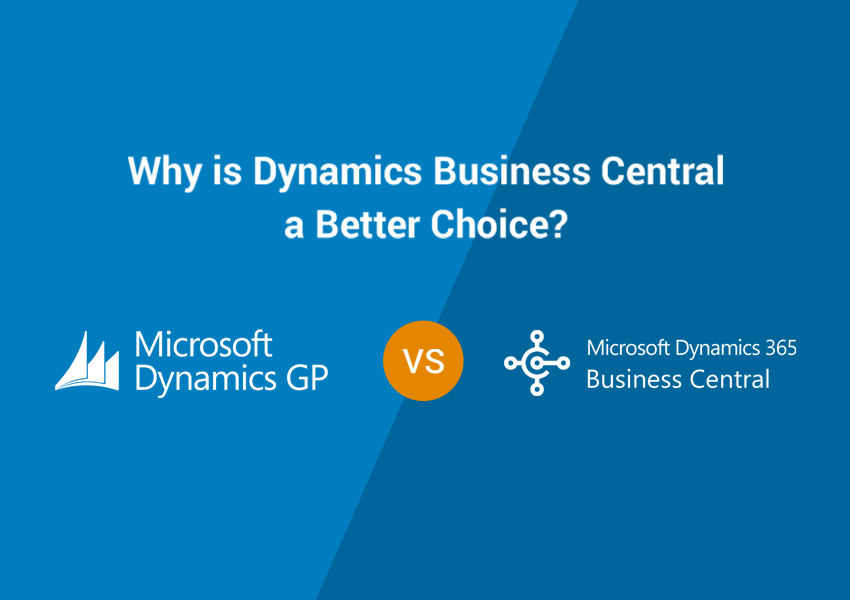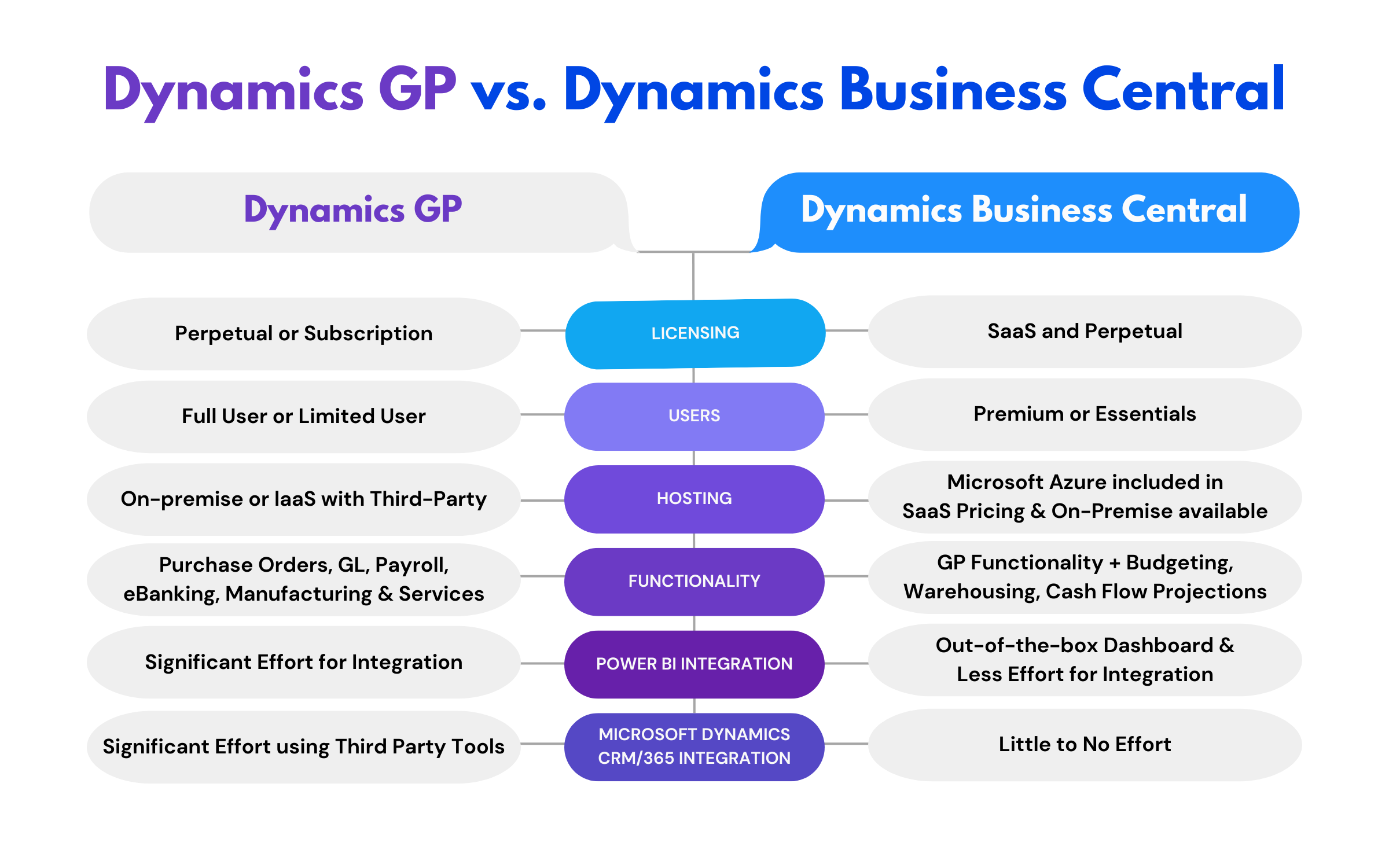Blog
Dynamics GP vs. Dynamics Business Central: Which ERP solution is best for you?

Microsoft Dynamics Business Central and Dynamics GP are Enterprise Resource Planning(ERP) solutions with overlapping features and functionality. Even though these solutions have many things in common, several key differences make Business Central a better fit for your business.
This blog post will provide you with an overview of each solution and outline why some GP clients are switching to Dynamics Business Central.
Dynamics GP has long been hailed as the “power horse” of Microsoft’s ERP solutions. The versatile on-premise ERP system was introduced in the 1990s and is especially popular in the United States. As cloud solutions become more popular, more partners are offering hosted options for GP to clients who prefer their tried-and-true solution.
In 2018, Microsoft released its first SaaS cloud ERP, Dynamics Business Central. Despite its new name, Business Central on the cloud is heavily based on another ERP system – Microsoft Dynamics NAV. Both solutions are so similar that clients on NAV on-premise can “upgrade” to Business Central on the cloud with minimal disruption.

Cloud Vs. On-Premise
The main difference between Dynamics Business Central and Dynamics GP is their design. Originally designed for on-premise deployment, Dynamics GP has been updated to support some cloud features in recent years.
Due to Business Central’s cloud-based nature, it has no hardware requirements or associated costs. Microsoft manages upgrades automatically.
Microsoft Dynamics GP was designed as an on-premise solution and performs best when hosted on-premise. GP updates need to be scheduled with your software provider as they do not happen automatically, whether your business deploys it in the cloud or on-premise.
Microsoft’s Focus
Microsoft has placed Dynamics Business Central at the forefront of its cloud strategy. It is expected that Microsoft will continue to support its on-premise solutions, such as Dynamics GP, but will focus its R&D investment on cloud solutions.
Customizations and Extensions
The flexibility and interactivity of Business Central with Microsoft and other third-party applications is one of its key advantages. You can develop your own apps, download third-party apps through Microsoft AppSource, or utilize third-party services. Most app creation involves little to no coding because Business Central is designed to enhance customization.
There are many ways to customize and improve each user’s interface and numerous apps that extend Business Central’s capabilities. Using the Designer, users can quickly drag and drop fact boxes, data fields, tables, grids, and other previously hidden data. The UI can be improved with Visual Studio in ways beyond fundamental changes.
Dynamics GP, like Business Central, can connect with third-party software to increase its functionality, although building and maintaining integrations is more complicated. Dynamics GP add-ons are unavailable on Microsoft AppSource since only Microsoft Partners can install them. Banking add-ons for areas like payroll, fixed assets, and more are available as extensions, along with Adobe productivity connectors.
Although Dynamics GP has customizing possibilities, only a few UI elements can be changed or eliminated. Users can rearrange and remove specific fields to fit their tastes or make navigation more accessible using the “Customize this page” function. There are additional customization options, although most are insignificant, like setting font colors and list orders.
Comparing Business Central and GP’s ERP Pricing Models
Pricing for Dynamics GP is based on the number of concurrent users and includes a yearly maintenance fee. This annual fee covers regular updates. Microsoft unveiled the Modern Lifecycle Policy in October 2019. The Modern Policy provides ongoing support, including the most recent tax adjustments, new features, and bug fixes. By utilizing at least one of the three yearly scheduled Dynamics GP releases, customers stay up to date.
Should You Migrate to Dynamics Business Central from Dynamics GP?
If you presently use Dynamics GP, you might be debating whether to switch to Microsoft Dynamics Business Central. Here are some explanations as to why companies might decide to migrate:
- The annual cost of Dynamics GP is high.
- You want to take advantage of the benefits of cloud ERP, including better security, agility, and lower total cost of ownership.
- You discover that some essential business functions for which you depend on external applications have native support in Business Central or are available as apps through the Microsoft AppSource.
Conclusion
The way businesses operate and store their data is changing due to rapid technological advancements, and the cloud is the way of the future. Microsoft Dynamics Business Central is the best option for your company to get you on the path to growth, considering the costs associated with Dynamics GP and Business Central’s business acceleration capabilities. Business Central is a robust ERP solution; it’s cloud-hosted, easy to implement, and the last upgrade you’ll ever need.
Make the switch to Business Central and accelerate your business transformation. For a guided tour of Business Central, drop us a line.
Categories
- Upgrade
- Power BI
- Power Automate
- Partner Program
- Office 365
- Migration
- Industry Updates And Events
- Implementation
- Dynamics SL
- Dynamics NAV
- Dynamics GP
- Dynamics Business Central
- Dynamics 365 for Sales
- Dynamics 365 Field Service
- Dynamics 365
- CRM and ERP
- Construction365
- Blog
- Australia
Recent Posts
- Modernize Construction by Upgrading from Wennsoft to Construction365
- IAMCP 2024: Key Lessons from Microsoft Channel Partners’ Annual Conference
- Everything You Need to Know When Selecting an ERP System
- Top ERP Trends in 2024: Make Your Business Processes Future Ready
- Directions EMEA 2023 and Dynamics 365 Business Central’s Future








